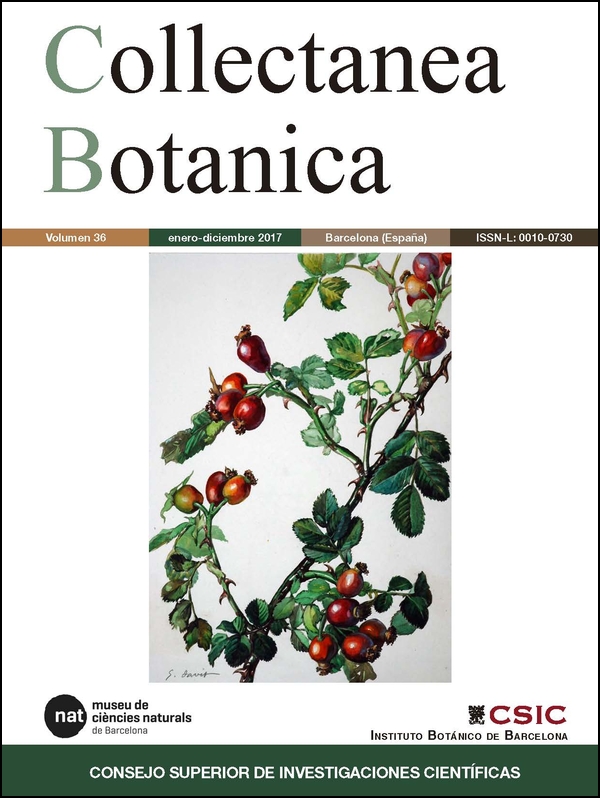A confirmed observation of Oxalis dillenii in Spain
DOI:
https://doi.org/10.3989/collectbot.2017.v36.004Keywords:
DNA barcode, identification, non-native speciesAbstract
We confirm the presence of Oxalis dillenii Jacq. in the Catalonian province Lleida (Catalonia, Spain). Identification was confirmed morphologically and through DNA barcode sequencing. A map of the distribution of O. dillenii is supplied, as are notes on its identification.
Downloads
References
Aymerich, P. 2013. Contribució al coneixement florístic del territorio ausosegàrric (NE de la península Ibèrica). Orsis 27: 209–259.
Bolòs, O. de, Vigo, J., Masalles, R. M. & Ninot, J. M. 1990. Flora manual dels Països Catalans. Pòrtic, Barcelona.
Chase, M. W. & Hills, H. H. 1991. Silica gel: an ideal material for field preservation of leaf samples for DNA studies. Taxon 40: 215–220. https://doi.org/10.2307/1222975
Gray, A. M. 2011. Oxalidaceae, version 2011:1. In: M. F. Duretto (Ed.), Flora of Tasmania Online. Tasmanian Herbarium, Tasmanian Museum & Art Gallery, Hobart: 8 pp. Retrieved September 3, 2015, from www.tmag.tas.gov.au/floratasmania.
Hassler, M. 2015. World Plants: Synonymic Checklists of the Vascular Plants of the World. Species 2000 Secretariat, Leiden. Retrieved March 25, 2015, from http://www.catalogueoflife.org/col/details/database/id/141
Hoste, I. 2012. Een sleutel voor het genus Oxalis in België, met commentaar bij de waargenomen soorten. Dumortiera 101: 9–22.
Katoh, K., Misawa, K., Kuma, K. I., & Miyata, T. 2002. MAFFT: a novel method for rapid multiple sequence alignment based on fast Fourier transform. Nucleic Acids Research 30: 3059–3066. https://doi.org/10.1093/nar/gkf436 PMid:12136088 PMCid:PMC135756
Moorsel, R. C. M. J. van, Beringen, R. & Odé, B. 2000. Een nieuwe klaverzuring in Nederland: Oxalis dillenii Jacq. Gorteria 26: 31–35.
Nesom, G. L. 2009. Again: taxonomy of yellow-flowered caulescent Oxalis (Oxalidaceae) in eastern North America. Journal of the Botanical Research Institute of Texas 3: 727–738.
Sánchez-Pedraja, O. 2015 Oxalis L. In: Mu-oz Garmendia, F. & Navarro, C. (Eds.), Flora iberica 9. Real Jardín Botánico (CSIC), Madrid: 384–405.
Simmons, M. P. & Ochoterena, H. 2000. Gaps as characters in sequence-based phylogenetic analyses. Systematic Biology 49: 369–381. https://doi.org/10.1093/sysbio/49.2.369 PMid:12118412
Taberlet, P., Geilly, L., Pautou, G. & Bouvet, J. 1991. Universal primers for amplification on three non-coding regions of chloroplast DNA. Plant Molecular Biology 17: 1105–1109. https://doi.org/10.1007/BF00037152 PMid:1932684
Tel-Zur, N., Abbo, S., Myslabodski, D. & Mizrahi, Y. 1999. Modified CTAB procedure for DNA isolation from epiphytic cacti of the genera Hylocereus and Selenicereus (Cactaceae). Plant Molecular Biology Reporter 17: 249–254. https://doi.org/10.1023/A:1007656315275
White, T. J., Bruns, T., Lee, S. J. W. T. & Taylor, J. W. 1990. Amplification and direct sequencing of fungal ribosomal RNA genes for phylogenetics. PCR protocols: a guide to methods and applications 18: 315–322.
Young, D. P. 1968. Oxalis L. In: Tutin T. G., Heywood, V. H., Burges, N. A. Moore, D. M., Valentine, D. H., Walters, S. M. & Webb, D. A. (Eds.), Flora Europaea 2. Cambridge University Press, Cambridge: 192–193.
Published
How to Cite
Issue
Section
License
Copyright (c) 2017 Consejo Superior de Investigaciones Científicas (CSIC)

This work is licensed under a Creative Commons Attribution 4.0 International License.
© CSIC. Manuscripts published in both the print and online versions of this journal are the property of the Consejo Superior de Investigaciones Científicas, and quoting this source is a requirement for any partial or full reproduction.
All contents of this electronic edition, except where otherwise noted, are distributed under a Creative Commons Attribution 4.0 International (CC BY 4.0) licence. You may read the basic information and the legal text of the licence. The indication of the CC BY 4.0 licence must be expressly stated in this way when necessary.
Self-archiving in repositories, personal webpages or similar, of any version other than the final version of the work produced by the publisher, is not allowed.














